Surrey facts for kids
Quick facts for kids
Surrey
|
|||||||||||||||||||||||||||||||||||||||||||||||||||||
|---|---|---|---|---|---|---|---|---|---|---|---|---|---|---|---|---|---|---|---|---|---|---|---|---|---|---|---|---|---|---|---|---|---|---|---|---|---|---|---|---|---|---|---|---|---|---|---|---|---|---|---|---|---|
|
|
|||||||||||||||||||||||||||||||||||||||||||||||||||||
| Sovereign state | United Kingdom | ||||||||||||||||||||||||||||||||||||||||||||||||||||
| Constituent country | England | ||||||||||||||||||||||||||||||||||||||||||||||||||||
| Region | South East | ||||||||||||||||||||||||||||||||||||||||||||||||||||
| Established | before 1066 | ||||||||||||||||||||||||||||||||||||||||||||||||||||
| Time zone | UTC±00:00 (Greenwich Mean Time) | ||||||||||||||||||||||||||||||||||||||||||||||||||||
| • Summer (DST) | UTC+01:00 (British Summer Time) | ||||||||||||||||||||||||||||||||||||||||||||||||||||
| Members of Parliament | List of MPs | ||||||||||||||||||||||||||||||||||||||||||||||||||||
| Police | Surrey Police | ||||||||||||||||||||||||||||||||||||||||||||||||||||
| Largest town | Woking | ||||||||||||||||||||||||||||||||||||||||||||||||||||
|
|||||||||||||||||||||||||||||||||||||||||||||||||||||
Surrey (/ˈsʌri/) is a county in South East England. It is one of the "home counties" that surround Greater London. Surrey shares borders with Greater London to the northeast, Kent to the east, East and West Sussex to the south, and Hampshire and Berkshire to the west. The biggest town in Surrey is Woking.
Surrey covers an area of about 1,663 square kilometers (642 square miles). It has a population of over 1.1 million people. Many northern parts of Surrey are suburbs of London, reaching towns like Woking, Guildford, and Leatherhead. The western part of the county connects to the Farnborough/Aldershot built-up area. The southern part of Surrey is more rural, with towns like Horley and Godalming.
The county has eleven local government areas called districts. These districts are part of the larger Surrey county government. Historically, Surrey included parts of what is now south-west Greater London. It did not include Spelthorne, which was part of Middlesex until 1965.
A key natural feature of Surrey is the North Downs. This is a chalk ridge that runs from southwest to northeast. It divides the busy northern areas from the quieter southern countryside. Two rivers, the Wey and the Mole, cut through the Downs. Both rivers flow into the Thames. The northern part of Surrey is a lowland area, part of the Thames basin. The southeast is part of the Weald, and the southwest includes the Surrey Hills. Surrey has the most woodland cover in England, with forests covering 22.4% of the county.
Contents
Exploring Surrey's Landscape
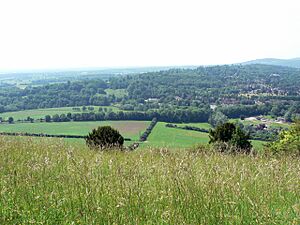
Surrey is split in two by the North Downs, a chalk ridge running east to west. The main rivers, the Wey and the Mole, flow through this ridge. These rivers are branches of the Thames, which used to form the county's northern border. North of the Downs, the land is mostly flat, forming part of the Thames basin. This area has a lot of London Clay and sandy soils.
South of the Downs, in the west, are the sandy Surrey Hills. Further east is the flat area of the Low Weald. Surrey has a lot of mature woodland, which is even shown in the county council's logo. Some famous beauty spots include Box Hill, Leith Hill, and Frensham Ponds. Surrey is the most wooded county in England. Box Hill has one of the oldest untouched natural woodlands in the UK. The county also has many areas of lowland heathland in the west.
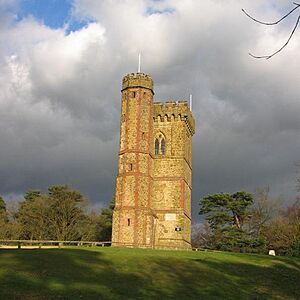
Because there isn't much intensive farming, Surrey has many common lands and public paths. These include the North Downs Way, a beautiful long-distance walking trail. This makes Surrey a great place for outdoor activities, especially horse riding.
The highest point in Surrey is Leith Hill near Dorking. It is about 295 meters (968 feet) above sea level. It is the second highest point in southeastern England.
Towns and Communities
Surrey has a population of about 1.1 million people. The largest town is Guildford, with around 66,773 residents. Woking is a close second with 62,796 people. Other large towns include Ewell (39,994) and Camberley (30,155). Towns with populations between 25,000 and 30,000 include Ashford, Epsom, Farnham, Staines, and Redhill.
Guildford is the historic county town. However, the county administration moved to Newington in 1791 and then to Kingston upon Thames in 1893. Since 1965, the county council's main offices have been outside Surrey's current borders. This happened when Kingston and other areas became part of Greater London.
Because it is so close to London, many people who live in Surrey travel to London for work. This makes Surrey a busy "commuter belt" area. It is one of the richest parts of the UK. Surrey is also Britain's most densely populated county, if you don't count Greater London and other major city areas.
A Look at Surrey's Past
Ancient Times: British and Roman Surrey
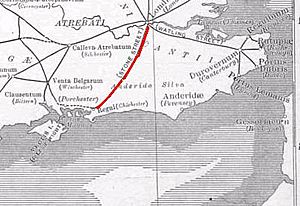
Before the Romans arrived, the area of Surrey was likely home to the Atrebates tribe. They controlled the southern bank of the Thames. In AD 43, the Romans invaded Britain. The Atrebates tribe was allied with Rome.
Roman roads like Stane Street crossed through Surrey. Remains of Roman temples have been found at Farley Heath and near Wanborough.
Saxon Surrey and Early Kingdoms
In the 5th and 6th centuries, Saxons settled in Surrey. The name Surrey comes from Suthrige, meaning "southern region." This might mean it was the southern part of a larger Middle Saxon territory.
By the 7th century, Surrey became a border area. Different kingdoms like Kent, Essex, Sussex, Wessex, and Mercia fought over it. In 825, Wessex finally took control of Surrey. It became a "shire" (a county) within Wessex.
Chertsey Abbey, founded in 666, was a very important religious place. It was first supported by the King of Kent. Later, it came under Mercian rule, and then Wessex.
Medieval Surrey: Castles and Trade
After the Battle of Hastings in 1066, the Norman army moved through Surrey. The Normans took over most of the land. In 1088, William de Warenne was given the title of Earl of Surrey.
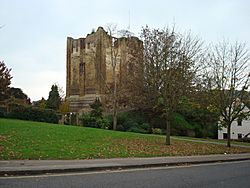
Guildford Castle was built by the Normans and became a royal palace. Farnham Castle was built for the Bishop of Winchester. Other castles were built at Bletchingley and Reigate.
A very important event happened in Surrey in June 1215. The Magna Carta was signed at Runnymede near Egham. This document was a major step towards limiting the power of the king.
Surrey was not a very rich area in the Middle Ages. Its soil was not great for farming. London's closeness also meant that towns in Surrey didn't grow as much. However, Surrey was known for making woollen cloth. Guildford cloth, called "gilforte," was sold all over Europe.
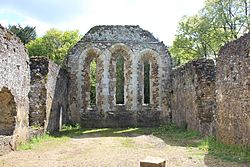
Many monasteries were founded in Surrey during this time. These included Waverley Abbey, the first Cistercian monastery in England, founded in 1128. All these monasteries were later closed during the Dissolution of the Monasteries in the 16th century.
People from Surrey used to be nicknamed "Surrey capons." This was because Surrey was known for fattening chickens for London's meat markets.
Early Modern Surrey: Palaces and Industry
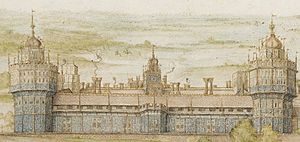
In the early Tudor period, grand royal palaces were built in northern Surrey, close to London. These included Richmond Palace and the amazing Nonsuch Palace near Ewell. Sadly, all these palaces have since been taken down.
Surrey's cloth industry declined in the 16th and 17th centuries. However, new industries grew, especially along the Tillingbourne valley. These included making paper and gunpowder. For a time, Surrey's mills were the main producers of gunpowder in England. The Wey and Godalming Navigations, opened in 1653, was one of England's first canal systems.

George Abbot, who became Archbishop of Canterbury, was from Guildford. He founded Abbot's Hospital, an almshouse, in Guildford in 1619.
Bankside in Southwark, which was then part of Surrey, was London's main entertainment area. Many famous plays by William Shakespeare and others were performed there.
Surrey was mostly untouched by the main fighting during the English Civil War. However, in 1649, a group called the Diggers set up a community at St. George's Hill near Weybridge. They wanted to live by ideas of common ownership, but local landowners eventually forced them out.
Modern Surrey: Growth and Changes
Until the late 1700s, Surrey was mostly rural. But with better roads and the arrival of railways in the 1830s, things changed. People working in London could now live in Surrey and travel to work daily. This led to a huge increase in Surrey's population and wealth. Towns like Guildford and Croydon grew fast, and new towns like Woking and Redhill appeared along the railway lines.
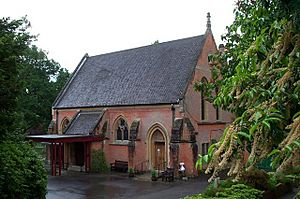
London also expanded into northeastern Surrey. In 1889, the County of London was created, taking parts of Surrey. In 1965, Greater London was formed, and more areas like Croydon and Kingston left Surrey. However, Staines and Sunbury-on-Thames joined Surrey. In 1974, Gatwick Airport was moved to West Sussex.
In 1849, Brookwood Cemetery was built near Woking to serve London. It became the largest burial ground in the world. Woking also got Britain's first crematorium in 1878 and its first mosque in 1889. In 1881, Godalming became the first town in the world with a public electricity supply.
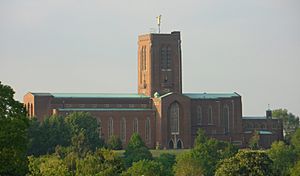
Surrey became important in architecture in the late 1800s. Its traditional building styles influenced the Arts and Crafts Movement. Many early works by famous architect Edwin Lutyens were built in Surrey.
New industries also developed. Dennis Brothers started in Guildford in 1895, making bicycles, cars, and later fire engines and buses. This company still operates today.
During the Second World War, a defense line called the GHQ Line was built across the North Downs in Surrey. This was to protect London from invasion.
Historic Buildings and Sites
Surrey has some ancient sites. You can find round barrows and bell barrows from the Bronze Age. There are also remains of Iron Age hillforts at places like Holmbury Hill and St. George's Hill. Only small parts of the Roman roads like Stane Street are still visible.
Some churches in Surrey have parts that date back to the Anglo-Saxon period. Examples include churches in Guildford, Godalming, and Stoke D'Abernon.
Many medieval churches exist, but they are usually small. Parts of Waverley Abbey and Newark Priory still stand as ruins. Farnham Castle still has much of its medieval structure.
Not many non-military buildings from before the 15th century survive. However, you can see some houses and barns from that time, often with later changes.
Important 16th-century buildings include the grand country houses of Loseley Park and Sutton Place. Abbot's Hospital, built in 1619, is a large building in the Tudor style. Other 17th-century examples include West Horsley Place and the Guildhall in Guildford.
Surrey's Economy
Surrey has a strong economy, partly because many residents work in financial services.
Many company headquarters are located in Surrey. These include electronics companies like Canon, Toshiba, and Samsung. Car companies like Kia Motors and Toyota UK also have offices here. Big food and household product companies like Unilever, Procter & Gamble, and Nestlé have their UK or European headquarters in Surrey. Non-profit organizations like WWF UK are also based here.
Getting Around Surrey
Roads
Three major motorways cross Surrey:
- The M25 (London Orbital) goes through the county. It has 8 junctions in Surrey and connects to other major motorways like the M1, M4, and M40. It's also close to Heathrow Airport.
- The M3 crosses northwest Surrey. It links London to Southampton.
- The M23 connects to Brighton. It has a junction near Gatwick Airport on the Surrey/Sussex border.
Other important roads include:
- The A3 trunk road runs from Portsmouth to London. It bypasses towns like Haslemere, Godalming, and Guildford. The Hindhead Tunnel helps traffic avoid a busy area.
- The A24 goes from London to Littlehampton. In Surrey, it passes through Ewell, Epsom, and Dorking.
- The A31 heads west from Guildford to Farnham.
Trains
Many people in Surrey use trains to travel to Central London. South Western Railway serves most of the county, with regular trains to London Waterloo. Southern operates in other parts, providing services to London Bridge and London Victoria.
Major train lines include the Waterloo to Reading Line, South West Main Line, and Brighton Main Line. These lines connect towns like Staines, Woking, Guildford, and Redhill to London.
The only diesel train route is the east-west North Downs Line. It runs from Reading through Guildford, Dorking, and Redhill.
The busiest stations in Surrey are Guildford, Woking, Epsom, Redhill, and Staines.
Air Travel
Both Heathrow and Gatwick airports have parts of their perimeter roads in Surrey. There are also bus services from Surrey towns to Heathrow.
Fairoaks Airport near Woking is a private airfield with training schools. Redhill Aerodrome is also in Surrey.
Learning and Education
Surrey has a state-funded education system. There are 37 state secondary schools, 17 Academies, 7 sixth form colleges, and 55 state primary schools. The county also has 41 independent schools, including famous ones like Charterhouse.
Many state secondary schools in Surrey have sixth forms for older students. Colleges like Brooklands and Reigate offer technical courses and standard sixth-form studies.
Higher Education
Surrey is home to several universities:
- The University of Surrey is located in Guildford.
- The University for the Creative Arts (UCA) has campuses in Farnham and Epsom.
- Royal Holloway, University of London is based in Egham.
- The Guildford School of Acting is part of the University of Surrey.
Emergency Services
Surrey is served by these emergency services:
- Surrey Police
- British Transport Police
- South East Coast Ambulance Service
- Surrey Fire & Rescue Service
- SURSAR (Surrey Search and Rescue)
Fun Places to Visit
Surrey has many beautiful natural areas. These include Box Hill near Dorking, the Devil's Punch Bowl at Hindhead, and Frensham Common. Leith Hill is the second highest point in southeast England. Witley Common and Thursley Common are large areas of ancient heathland. The Surrey Hills are a designated Area of Outstanding Natural Beauty.
You can also visit lovely gardens like Claremont Landscape Garden near Esher and Winkworth Arboretum near Godalming. Wisley is home to the famous Royal Horticultural Society gardens.
Historic houses include the Tudor mansion of Loseley Park and Clandon House, an 18th-century Palladian mansion. Polesden Lacey is a beautiful Regency villa with large grounds. Oakhurst Cottage is a restored 16th-century worker's home.
The Wey and Godalming Navigations is a canal system. You can learn about its history at Dapdune Wharf in Guildford.
Runnymede at Egham is a very important historical site. It's where the Magna Carta was signed in 1215.
Guildford Cathedral is a modern cathedral built in the 20th century.
For fun, visit Brooklands Museum, which celebrates Surrey's history in motoring and aviation. Thorpe Park is a popular theme park in the county.
Surrey in Popular Culture
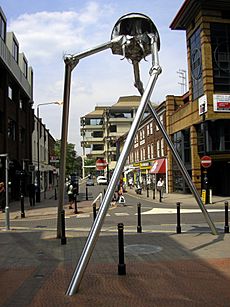
Many books and films are set in or inspired by Surrey.
- Jane Austen's novel Emma takes place in the fictional town of Highbury, Surrey. A famous picnic scene happens on Box Hill.
- Much of H. G. Wells' 1898 novel The War of the Worlds is set in Surrey. The Martians first land on Horsell Common in Woking.
- The character Ford Prefect from The Hitchhiker's Guide to the Galaxy jokingly claimed to be from Guildford, Surrey.
- In J. K. Rowling's Harry Potter series, Harry grows up in the fictional Little Whinging, Surrey, with the Dursleys.
- Surrey has been used as a film location. Guildford Cathedral was featured in the 1976 film The Omen. Parts of The Holiday and The Wedding Date were filmed in the village of Shere.
- The opening scene of Gladiator was filmed in the Bourne Woods near Farnham.
Famous People from Surrey
Writers
Many important writers have lived or worked in Surrey:
- John Evelyn (1620–1706) was born and lived much of his life in Wotton.
- William Cobbett (1763–1835) was born in Farnham. Surrey is featured in his book Rural Rides.
- Alfred Tennyson (1809–1892) spent his later life in Haslemere.
- Charles Dickens (1812–1870) wrote part of The Pickwick Papers in Dorking.
- Lewis Carroll (1832–1898) wrote Through the Looking-Glass while visiting his sisters in Guildford.
- H. G. Wells (1866–1946) wrote The War of the Worlds while living in Woking.
- P. G. Wodehouse (1881–1975) was born in Guildford.
- Aldous Huxley (1894–1963), author of Brave New World, was born and raised in Godalming.
Arts and Sciences
- William of Ockham (c.1288–1347), a famous philosopher, came from Ockham.
- Thomas Malthus (1766–1834), a pioneer in population studies, was born in Westcott.
- Ada Lovelace (1815–1852), a brilliant mathematician, lived at East Horsley.
- Eadweard Muybridge (1830–1904), a photography pioneer, was born in Kingston.
- Gertrude Jekyll (1843–1932), a famous garden designer, lived near Godalming.
- Edwin Lutyens (1869–1944), a renowned architect, grew up in Thursley.
- Ralph Vaughan Williams (1872–1958), a famous composer, grew up at Leith Hill.
- Laurence Olivier (1907–1989), a legendary actor, was born in Dorking.
- Alan Turing (1912–1954), a key figure in computer science, lived in Guildford.
- Alex Kingston (born 1963), an actress, was born and raised in Epsom.
- Tom Holland (actor) (born 1996), actor, is from Kingston Upon Thames.
Music
Surrey has been a birthplace for many musicians, especially in the 1960s British blues scene.
- Roger Waters (born 1943) of Pink Floyd was born in Great Bookham.
- Jimmy Page (born 1944) of Led Zeppelin spent his early life in Epsom.
- Eric Clapton (born 1945), famous guitarist, was born and grew up in Ripley.
- Peter Gabriel (born 1950) was born in Chobham. His band Genesis formed at Charterhouse School in Godalming.
- Paul Weller (born 1958) was born and grew up in Woking, which inspired his song "Town Called Malice". His band The Jam formed there.
- The band Sham 69 formed in Hersham in 1975.
- The Police recorded their first two albums in Leatherhead.
- Norman Cook, also known as Fatboy Slim (born 1963), grew up in Reigate.
Sports
- Cricket has a long history in Surrey. The game was played at the Royal Grammar School, Guildford in the 16th century. Surrey County Cricket Club plays at The Oval in London and also at Woodbridge Road in Guildford.
- Epsom Downs Racecourse hosts the famous Epsom Derby, a major horse race. Surrey also has Lingfield, Kempton, and Sandown Park Racecourses.
- Brooklands was the world's first purpose-built motorsport race circuit, opened in 1907. The headquarters of the McLaren Formula One team are in Woking.
- Surrey is home to the ice hockey team Guildford Flames and the basketball team Surrey Scorchers.
- Chelsea F.C. football club trains at the Cobham Training Centre in Stoke d'Abernon.
See also
 In Spanish: Surrey para niños
In Spanish: Surrey para niños












